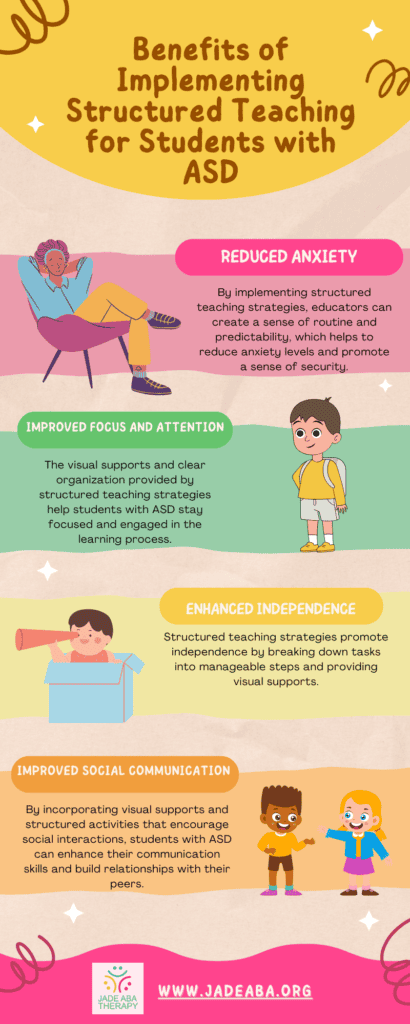Traditional teaching methods that heavily rely on verbal instructions and social reinforcement may not effectively support students with Autism Spectrum Disorder (ASD). Therefore, utilizing structured teaching strategies is essential in creating a supportive learning environment for these students.

Autism Teaching Strategies Overview
Autism teaching strategies are specifically designed to address the challenges faced by individuals with ASD in the classroom. These strategies aim to enhance their educational success and overall well-being by capitalizing on their strengths and providing support where needed.
One size does not fit all when it comes to teaching autistic students. Tailored approaches are paramount because every student with ASD is unique and may have different strengths, challenges, and learning styles. What works for one student may not work for another. Therefore, teachers should take the time to understand each student’s individual needs and preferences.
Structured teaching strategies, which are based on an in-depth understanding of how autism affects thinking, learning, and behavior, provide a framework for tailoring approaches to meet the needs of students with ASD. These strategies incorporate predictable routines, visual supports, and organized classroom spaces to enhance engagement and independence.
By implementing effective teaching strategies that are specifically tailored to one student’s needs, educators can help them thrive in the classroom. It is important to remember that collaboration with families, ongoing assessment, and flexibility are key components in implementing these strategies successfully.

Understanding Autism Spectrum Disorder
To effectively navigate the classroom and implement appropriate teaching strategies for autistic students, it’s crucial to have a solid understanding of ASD. This section will provide an overview of the prevalence and characteristics of ASD, as well as the sensory sensitivities often experienced by individuals on the spectrum.
Prevalence and Characteristics
The Johns Hopkins Bloomberg School of Public Health reports that since 2000, the prevalence of ASD has almost tripled. An estimated 31% of children diagnosed with ASD also have an intellectual disability. ASD is a developmental condition that impacts people in many areas of their lives, such as behavior, social interaction, and communication.
The characteristics of ASD can vary widely from person to person. Some common traits include difficulties with social interaction and communication, repetitive behaviors or restricted interests, and challenges with sensory processing. It’s important to remember that individuals with ASD have unique strengths and abilities, and their needs should be addressed through tailored teaching approaches.
Sensory Sensitivities in ASD
Hypersensitivity, such as overreactions to their surroundings, is experienced by people with ASD. Different manifestations of sensory sensitivity can include discomfort with particular textures, sensitivity to bright lights, or aversion to specific sounds. These sensitivity levels can have a big effect on a student’s concentration, participation in class activities, and ability to move around the classroom.
To support students with ASD effectively, it is essential to recognize and accommodate their unique characteristics, including sensory sensitivities. By making adjustments to the classroom environment, such as reducing excessive noise or providing sensory breaks, educators can help minimize potential sensory triggers and promote a more comfortable learning experience.
Evidence-Based Teaching Approaches
When it comes to teaching strategies for autistic students, it’s important to rely on evidence-based approaches that have been proven effective in supporting their unique learning needs. Two such approaches are Applied Behavior Analysis (ABA) therapy and Structured Teaching strategies.
ABA Therapy
ABA therapy is widely recognized as an effective intervention for individuals with ASD. This therapy utilizes rewards and incentives to reinforce desired behaviors and teach new skills. ABA therapy has been extensively researched and has shown significant benefits in areas such as socialization, communication, and expressive language skills.
ABA therapy is often implemented by trained professionals, such as behavior analysts or therapists, who work closely with the individual to develop individualized goals and implement tailored strategies. The key principles of ABA therapy include breaking down complex skills into smaller, achievable steps, using positive reinforcement to encourage desired behaviors, and systematically fading out prompts and support over time.
Structured Teaching Strategies
Due to differences in auditory processing, replication, motivation, and management, traditional teaching strategies that primarily rely on spoken instructions, examples, and peer reinforcement may not be able to adequately support students with ASD. Conversely, structured teaching methods are created especially to meet the special learning requirements of people with ASD.
The Division TEACCH’s Structured Teaching Model is a well-known example of a comprehensive treatment approach that incorporates Structured Teaching strategies. This model focuses on an in-depth understanding of autism, collaboration with families, personalized assessment for strategy development, and skill development across various curriculum areas, with particular attention to communication and social skills.
Structured Teaching Components
Structured Teaching Strategies for Students on the Autism Spectrum encompass four main components: physical structure, visual supports, work systems, and visual structure. These strategies are designed to support individuals with ASD by providing predictable routines, incorporating visual supports, and organizing classroom spaces and materials to reduce anxiety and increase appropriate behavior.
Physical Structure
The physical structure of the classroom plays a crucial role in supporting students with ASD. By creating a structured and organized environment, students can better focus on learning and feel more secure. Some key elements of the physical structure include:
- Clear and defined spaces: Designate different areas for different activities, such as a reading corner, a quiet area, and a workstation. Clearly mark these spaces to help students understand their purpose.
- Visual boundaries: Use visual cues like tape on the floor or colored mats to define personal spaces for each student. This can help reduce sensory overload and promote a sense of ownership and structure.
- Reduced visual clutter: Minimize distractions by keeping the classroom free from excessive visual stimuli. Organize materials and resources in labeled bins or shelves to maintain order and accessibility.
Visual Supports
Visual supports are powerful tools for students with ASD, as they provide visual information to supplement verbal instructions and enhance understanding. Some effective visual supports include:
- Visual schedules: Visual schedules help students understand and anticipate daily activities. Use pictures, symbols, or written words to represent each task or activity. Display the schedule prominently in the classroom to provide a visual roadmap of the day.
- Visual timers: Visual timers help students track the duration of activities and transitions. Use timers with clear visual indicators, such as color changes or diminishing segments, to help students grasp the concept of time and manage their schedules effectively.
- Visual cues and prompts: Visual cues, such as visual reminders or step-by-step instructions, can support students in following routines, completing tasks, and understanding expectations. These cues can be in the form of pictures, icons, or written instructions, depending on the student’s preferences and abilities.
Work Systems
Work systems are structured methods of organizing and presenting tasks to students with ASD. These systems promote independence, self-regulation, and task completion. Some common types of work systems include:
- Task organization: Break tasks into smaller, manageable steps and present them in a clear and sequential manner. This helps students understand the expectations and progress through the task independently.
- Visual supports for task completion: Use visual supports, such as checklists or task cards, to guide students through the steps of a task. Students can visually track their progress and experience a sense of accomplishment as they complete each step.
- Individualized work systems: Tailor the work system to each student’s unique needs and abilities. Consider factors such as visual presentation, task complexity, and level of support required. Individualized work systems can empower students to work at their own pace and build confidence in their abilities.
Division TEACCH’s Structured Teaching Model
A comprehensive treatment approach developed by Division TEACCH in North Carolina, the Structured Teaching Model is designed to support individuals with ASD across their lifespan. This model focuses on a deep understanding of autism, collaboration with families, personalized assessment for strategy development, and skill development across various curriculum areas.
Comprehensive Treatment Approach
The Structured Teaching Model developed by TEACCH addresses the special needs of learners with ASD by using a comprehensive approach. Given that students with ASD may differ in their auditory processing, replication, motivation, and management, it acknowledges that traditional teaching strategies—which mainly rely on verbal instructions, examples, peer encouragement, and information sequencing—might not be able to support them.
Focus on Communication and Social Skills
Within the Structured Teaching Model, there is a specific emphasis on addressing communication and social skills because individuals with ASD often face challenges in these areas. By incorporating strategies that promote communication and social interaction, the Structured Teaching Model aims to enhance one’s ability to engage effectively with others and navigate social situations.

Implementing Structured Teaching
Structured teaching strategies have proven to be highly beneficial for students with ASD. By implementing these strategies, educators can create predictable and supportive learning environments that cater to the unique needs of students on the autism spectrum. This section will explore the benefits of structured teaching for students with ASD and the importance of creating predictable learning environments.
Benefits for Students with ASD
Structured teaching strategies offer several key benefits for students with ASD. These strategies provide the necessary support and accommodations to help students navigate the challenges they may face in the classroom. Some of the benefits include:
- Reduced Anxiety: Students with ASD often thrive in structured and predictable environments. By implementing structured teaching strategies, educators can create a sense of routine and predictability, which helps to reduce anxiety levels and promote a sense of security.
- Improved Focus and Attention: The visual supports and clear organization provided by structured teaching strategies help students with ASD stay focused and engaged in the learning process. These strategies help to minimize distractions and provide a clear framework for understanding and completing tasks.
- Enhanced Independence: Structured teaching strategies promote independence by breaking down tasks into manageable steps and providing visual supports. This allows students to work through tasks at their own pace and build confidence in their abilities.
- Improved Social Communication: Many structured teaching strategies focus on communication and social skills development. By incorporating visual supports and structured activities that encourage social interactions, students with ASD can enhance their communication skills and build relationships with their peers.
Creating Predictable Learning Environments
Creating a predictable learning environment is a fundamental aspect of structured teaching. By establishing routines, incorporating visual supports, and organizing classroom spaces, educators can create an environment that supports the learning and development of students with ASD.
- Establishing Routines: Routines provide a sense of structure and predictability for students with ASD. Establishing consistent daily routines and clearly communicating transitions can help reduce anxiety and increase participation and engagement. Visual schedules and timers can be used to help students understand and anticipate upcoming activities and transitions.
- Incorporating Visual Supports: Visual supports, such as visual schedules, social stories, and visual cues, play a crucial role in structured teaching. Visual supports help students with ASD understand expectations, follow routines, and navigate social interactions. They provide a visual representation of information, making it more accessible and easier to understand.
- Organizing Classroom Spaces: A well-organized classroom can greatly benefit students with ASD. Clear and consistent physical structures, including designated areas for different activities, visually organized materials, and labeled storage spaces, can help students navigate the classroom environment more independently and reduce sensory overload.
The Takeaway
By implementing structured teaching strategies and creating predictable learning environments, educators can effectively support the learning and development of students with ASD. These strategies provide the necessary structure and support to help students thrive academically, socially, and emotionally.
Sources:
- https://www.nu.edu/blog/4-teaching-strategies-for-students-with-autism/
- https://www.autismspeaks.org/tool-kit-excerpt/autism-classroom-strategies
- https://files.eric.ed.gov/fulltext/EJ1230708.pdf
- https://www.readingrockets.org/topics/autism-spectrum-disorder/articles/structured-teaching-strategies-students-autism-spectrum